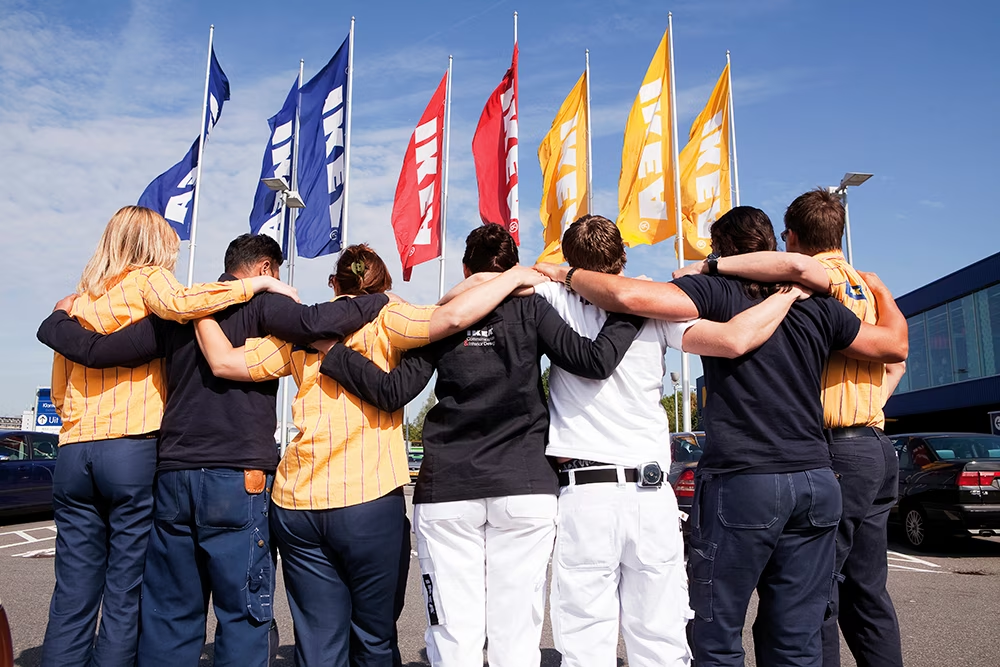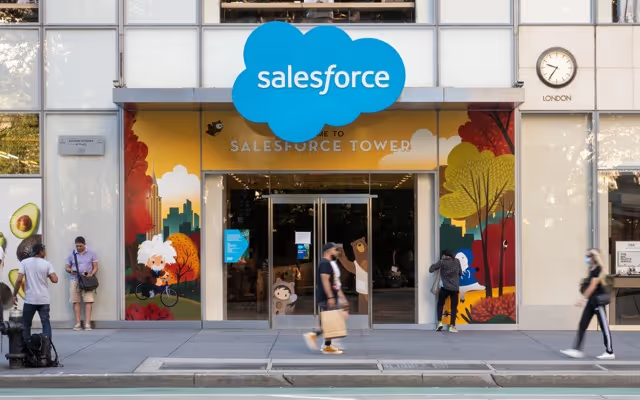Stronger brands and happier workplaces.
Branding is everywhere - what we buy, where we work, what we trust. But with so many theories - brand engagement, employer brands, employee value propositions - it’s easy to get lost. But a brand isn’t just what a company says it is. It’s what employees believe and what customers experience.

The best brands align brand and culture.
Don’t just tell a story. Live that story at every level.
A company can’t promise quality, innovation, or trust to the outside world if its employees don’t understand, believe, or experience those same values every day.
When a brand’s culture and external message match, employees become natural ambassadors, delivering authentic experiences that customers recognise and trust. That’s what real brand engagement looks like.

IKEA
IKEA keeps prices low by making efficiency part of its work culture—from product design to store layouts.

Salesforce
Salesforce sells trust as a product and reinforces it with a workplace built on transparency and strong values.

Spotify
Spotify gives users freedom in how they listen, just like it gives employees freedom in how they work.
Turn your brand into something people believe in.
Many companies struggle to connect their brand message with real action. The result? Inconsistent experiences, disengaged employees, and customers who move on.
Define what your brand stands for.
Align internal culture with external brand.
Create lasting engagement.
The 7-step brand engagement framework ensures that every part of a business - marketing, HR, leadership, and employees work together to create a brand that people trust, choose, and stay with.
The 7 steps to align brand and culture.
A great brand isn’t just seen. It’s felt by both employees and customers. These seven steps provide a clear roadmap to creating a brand that people trust, engage with, and advocate for. From defining your identity to building true loyalty, this strategy ensures your internal and external brands work together for lasting success.
A brand’s identity is what connects its people, products, and customers.
A strong brand isn’t just a logo - it’s a clear promise, a defined product or service, and a message that makes sense to both employees and customers. Without these, a brand is just a name with no reason for people to care.
For Employees
They need to know what the company does, what it values, and how their work contributes. A brand with no clear direction leads to disengaged teams and an inconsistent experience.
For Customers
A brand must be more than words. It needs a product or service that delivers on its message. If a company claims to be premium but offers poor service, customers won’t trust it.
Build the foundation - a brand people recognise, understand, and believe in.
People won’t choose your brand if they don’t recognise it.
Once a brand has a clear identity, the next step is to make sure people see it consistently and connect it to what it actually offers. Employees should know who they work for and what the brand stands for, and customers should be able to recognise it instantly in a crowded market.
For Employees
The brand should be part of everyday work. How leaders communicate, how teams operate, and how decisions are made. If employees don’t see the brand reflected in their workplace, it’s just a logo on their paycheck.
For Customers
The brand should be instantly recognisable in every interaction. From marketing and products to service and communications, each interaction should clearly show what the brand stands for. If customers can’t quickly identify the brand or understand its value, it will struggle to stand out in a crowded market.
Show up where your audience is with strong visual branding, clear messaging, and consistent experiences across every touchpoint, inside and outside the company.
Recognition gets their attention, engagement makes them care.
Once people recognise a brand, the next step is to get them to interact with it in a real way. Customers need a reason to explore what the brand offers, and employees need to feel connected beyond just their job title.
For Employees
Engagement means involvement. This could be through team initiatives, feedback loops, or company culture that encourages participation. When employees see their input valued, they feel invested in the brand’s success.
For Customers
Engagement happens when people take action - clicking a link, signing up for a newsletter, leaving a review, or trying the product for the first time. Brands create engagement by sparking curiosity, offering value, and making interactions easy and rewarding.
A brand that people engage with is a brand people will invest in.
This is the moment of decision - when people commit to your brand.
Engagement creates interest, but selection is where customers and employees make a real choice. A customer makes their first purchase, or an employee decides to stay and build their career. At this point, the brand needs to remove doubts and reinforce why it's the right decision.
For Employees
They choose to stay when they see a future—clear career paths, strong leadership, and a workplace that supports them. If a company fails here, employees start looking elsewhere.
For Customers
A great product or service isn’t enough; the buying experience must be seamless. Simple checkout processes, transparent pricing, and strong customer support make choosing the brand easy.
If selection feels like a risk, people walk away. The best brands make it effortless, reassuring, and rewarding.
People have chosen your brand - now give them a reason to stay.
Getting someone to choose your brand once is a win, but real success comes when they keep coming back. Loyalty isn’t automatic - it’s earned through consistent value, trust, and great experiences. Whether it’s reliable products, responsive service, or a workplace where employees feel valued, brands must prove they’re worth sticking with.
For Employees
Loyalty grows when people see a future - clear career paths, strong leadership, and a culture that recognises their contributions. If they feel overlooked, they’ll start looking elsewhere.
For Customers
A great first experience isn’t enough—people stay loyal when they get consistent quality, transparency, and real value. If expectations aren’t met, they won’t hesitate to move on.
Loyalty is what keeps people from leaving. When a brand delivers every time, the competition fades into the background.
Loyalty is strong - now make your brand the only choice.
Loyal customers come back, but insistent customers and employees refuse to go anywhere else. They don’t just prefer your brand—they actively avoid alternatives, recommend it to others, and stick with it even when faced with challenges. This happens when brands go beyond expectations—offering exceptional service, exclusive benefits, and a real sense of belonging.
For Employees
They turn down job offers because they see real growth where they are. They take pride in the brand, defend its reputation, and promote it in their personal and professional circles. They don’t just work for the company—they represent it.
For Customers
They drive further to visit your store, wait for your product to restock, or choose your service even when competitors offer discounts. They’re the ones who tell their friends, wear the merch, and stay engaged long after the purchase.
Commitment is built through consistently delivering quality, rewarding loyalty, and making people feel valued. Create experiences people don’t want to lose and become irreplaceable.
Your brand isn’t just trusted - it’s loved and defended.
Insistence means people won’t switch. Devotion goes further—they actively promote your brand, defend it, and feel personally connected to it. Brands build this by creating real relationships, making customers and employees feel valued, and giving them experiences they want to be part of—whether it’s exclusive events, behind-the-scenes access, community-building, or true support.
For Employees
They don’t just work for the company—they bring in talent, advocate for it, and take pride in its success. This comes from leadership that listens, meaningful career growth, and a company culture that feels like a shared mission.
For Customers
They recommend your brand constantly, wear the merch, engage in the community, and stay loyal through ups and downs. This happens when brands reward engagement, offer VIP experiences, and align with their audience’s values.
Devoted brands don’t just sell. They create belonging. They have customers and employees who champion them, defend them, and want to see them win. That’s how brands become movements.
Engage your employees. Engage your customers.
True brand engagement isn’t a one-time effort. It’s a continuous process of alignment, consistency, and connection. Companies that succeed don’t just market well; they build cultures where employees and customers believe in the brand and actively support it.